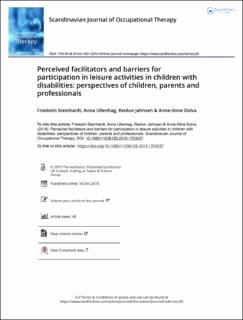| dc.contributor.author | Steinhardt, Friedolin | |
| dc.contributor.author | Ullenhag, Anna | |
| dc.contributor.author | Jahnsen, Reidun Birgitta | |
| dc.contributor.author | Dolva, Anne-Stine | |
| dc.date.accessioned | 2020-04-01T08:35:25Z | |
| dc.date.available | 2020-04-01T08:35:25Z | |
| dc.date.created | 2020-01-02T12:25:38Z | |
| dc.date.issued | 2019 | |
| dc.identifier.citation | Scandinavian Journal of Occupational Therapy. 2019 | en_US |
| dc.identifier.issn | 1103-8128 | |
| dc.identifier.uri | https://hdl.handle.net/11250/2649808 | |
| dc.description | © 2019 The Author(s). Published by Informa UK Limited, trading as Taylor & Francis Group This is an Open Access article distributed under the terms of the Creative Commons Attribution-NonCommercial-NoDerivatives License (http://creativecommons.org/licenses/by-nc-nd/4.0/), which permits non-commercial re-use, distribution, and reproduction in any medium, provided the original work is properly cited, and is not altered, transformed, or built upon in any way. | en_US |
| dc.description.abstract | Background: There is limited knowledge about facilitators and barriers to leisure activity participation for children with disabilities in Norway, which is needed to improve rehabilitation interventions. Aim: This study aims to explore the main facilitators and barriers for participation in leisure activities for children and youth with disabilities in Norway. Methods: Semi-structured group interviews with 31 parents, 20 healthcare professionals, and nine children with disabilities were conducted. Qualitative content analysis with thematic coding was used, and the model of factors affecting the participation of children with disabilities developed by King et al. was applied for further deductive analysis. Results: Child factors, as viewed by parents and professionals, worked primarily as barriers and tended to increase with the child’s age. The children themselves focussed on their own preferences, friendship and enjoyment as their main facilitators for participation. Most environmental and family factors worked both as facilitators and as barriers, with parental support as the most important facilitator. Differences between urban and rural areas in the availability and accessibility of activities were reported. Conclusion and significance: Knowledge from this study is important for the improvement of rehabilitation interventions that aim to increase participation in leisure activities for children and youth with disabilities. | en_US |
| dc.language.iso | eng | en_US |
| dc.rights | Attribution-NonCommercial-NoDerivatives 4.0 Internasjonal | * |
| dc.rights.uri | http://creativecommons.org/licenses/by-nc-nd/4.0/deed.no | * |
| dc.subject | children | en_US |
| dc.subject | disability | en_US |
| dc.subject | leisure activities | en_US |
| dc.subject | measurement | en_US |
| dc.subject | participation | en_US |
| dc.title | Perceived facilitators and barriers for participation in leisure activities in children with disabilities: perspectives of children, parents and professionals. | en_US |
| dc.type | Peer reviewed | en_US |
| dc.type | Journal article | en_US |
| dc.description.version | publishedVersion | en_US |
| dc.source.journal | Scandinavian Journal of Occupational Therapy | en_US |
| dc.identifier.doi | 10.1080/11038128.2019.1703037 | |
| dc.identifier.cristin | 1765136 | |
| cristin.unitcode | 209,4,5,0 | |
| cristin.unitname | Institutt for sosialfag og veiledning | |
| cristin.ispublished | true | |
| cristin.fulltext | original | |
| cristin.qualitycode | 1 | |

